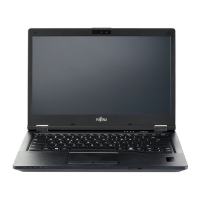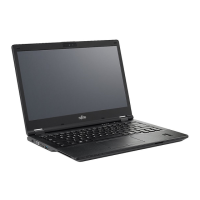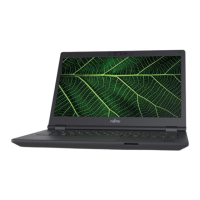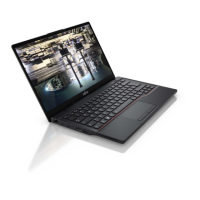Do you have a question about the Fujitsu LIFEBOOK E5510 and is the answer not in the manual?
Device compliance with FCC rules, including interference and operation conditions.
Instructions for safe operation, handling, environment, and electrical connections.
Precautions for battery replacement, disposal, and charger use.
Explanation of Point, Caution, and Warning icons used in the manual.
Information on correcting interference and connecting to the telephone network.
Restrictions on telephone service usage and hearing aid compatibility.
Explanation of sleep mode and benefits of energy efficiency.
Safety advice on grounding, adapter use, fuses, and battery replacement.
Legal and environmental guidelines for battery disposal.
Prohibits use in critical applications and advises data backup for repairs.
Identifies and describes the front components and status indicator LEDs of the LIFEBOOK.
Identifies and describes the right-side ports and connectors of the LIFEBOOK.
Identifies and describes the left-side ports and connectors of the LIFEBOOK.
Identifies and describes the bottom components, slots, and battery bay.
Detailed explanation of status indicator LEDs and storage drive access warning.
How to operate on battery, recharge, and interpret charging indicators.
How to check battery level and considerations for indicator accuracy.
Managing low battery status, data loss risks, and temperature alarms.
Overview of power management features, suspend, and hibernation modes.
How to control hibernation and adjust fan speed settings.
Windows power settings, restart, and safe shutdown procedures.
Steps for connecting the AC adapter and initial battery charging.
Procedures for powering the notebook on/off safely and handling precautions.
Notes on keyboard wear and its design for enhanced functions.
Descriptions of basic keys like Backspace, Tab, Enter, Caps Lock, Shift, Fn, Cursor, Windows, and Menu keys.
Explains function keys and key combinations for Windows and applications.
Descriptions of function keys F1 through F10 and their specific uses.
Details on F11/F12, key combinations, and keyboard backlight control.
Information about SIM card support, functionality, and slot location.
Step-by-step instructions for inserting a SIM card into the notebook.
Step-by-step instructions for removing a SIM card from the notebook.
Explains BIOS utility, its menus, and how to start the setup.
Instructions on how to navigate and change settings within the BIOS Setup Utility.
Details on saving/discarding changes and exiting the BIOS Setup Utility.
Overview of security features and steps to configure the fingerprint sensor.
Steps to configure palm vein sensor and use the security lock.
Guide to setting up and managing BIOS password protection.
Steps for assigning, changing, and removing BIOS passwords.
How to set up password protection for OS boot and hard disk.
Explanation of TPM and step-by-step instructions for enabling it.
Information on Smartcard reader usage and how to insert a Smartcard.
Step-by-step guide for changing the notebook battery with safety precautions.
Information on adding memory modules, slots, and valid configuration combinations.
Step-by-step guide for installing memory modules with safety warnings.
Identifies and describes all ports and connectors on the port replicator.
Steps to connect and disconnect the notebook from the port replicator safely.
Overview of the USB Type-C Port Replicator and its left-side ports.
Identifies and describes the right-side ports of the USB Type-C Port Replicator.
Guide to setting up the Port Replicator and connecting its mains adapter.
Step-by-step guide for connecting the LIFEBOOK to the USB Type-C Port Replicator.
How to operate and disconnect the LIFEBOOK using the Port Replicator.
How to register the notebook and find service center information.
Procedure to identify problems and information needed for customer support.
| Operating System | Windows 10 Pro |
|---|---|
| Graphics | Intel UHD Graphics |
| Processor | Intel Core i5-10210U |
| Storage | Up to 1TB SSD |
| Display | 15.6-inch, 1920 x 1080 pixels |
| Battery | 4-cell |
| Ports | 1 x HDMI, 1 x VGA, 1 x Audio Combo |
| Wireless | Wi-Fi 6, Bluetooth 5.0 |











